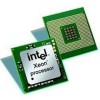Intel X5472 Data Sheet - Page 95
Processor Thermal Data Sample Rate and Filtering
 |
UPC - 735858201551
View all Intel X5472 manuals
Add to My Manuals
Save this manual to your list of manuals |
Page 95 highlights
Thermal Specifications should utilize the relative temperature value delivered over PECI in conjunction with the TCONTROL MSR value to control or optimize fan speeds. Figure 6-9 shows a conceptual fan control diagram using PECI temperatures. The relative temperature value reported over PECI represents the data below the onset of thermal control circuit (TCC) activation as needed by PROCHOT# assertions. As the temperature approaches TCC activation, the PECI value approaches zero. TCC activates at a PECI count of zero. Figure 6-9. Conceptual Fan Control Diagram of PECI-based Platforms Fan Speed (RPM) Min TCONTROL Setting Max PECI = -10 TCC Activation Temperature PECI = 0 PECI = -20 Temperature (not intended to depict actual implementation) 6.3.1.2 Processor Thermal Data Sample Rate and Filtering The Digital Thermal Sensor (DTS) provides an improved capability to monitor device hot spots, which inherently leads to more varying temperature readings over short time intervals. The DTS sample interval range can be modified, and a data filtering algorithm can be activated to help moderate this. The DTS sample interval range is 82us (default) to 20 ms (max). This value can be set in BIOS. To reduce the sample rate requirements on PECI and improve thermal data stability vs. time the processor DTS also implements an averaging algorithm that filters the incoming data. This is an alpha-beta filter with coefficients of 0.5, and is expressed mathematically as: Current_filtered_temp = (Previous_filtered_temp / 2) + (new_sensor_temp / 2). This filtering algorithm is fixed and cannot be changed. It is on by default and can be turned off in BIOS. Host controllers should utilize the min/max sample times to determine the appropriate sample rate based on the controller's fan control algorithm and targeted response rate. The key items to take into account when settling on a fan control algorithm are the DTS sample rate, whether the temperature filter is enabled, how often the PECI host will poll the processor for temperature data, and the rate at which fan speed is changed. Depending on the designer's specific requirements the DTS sample rate and alpha-beta filter may have no effect on the fan control algorithm. 95















